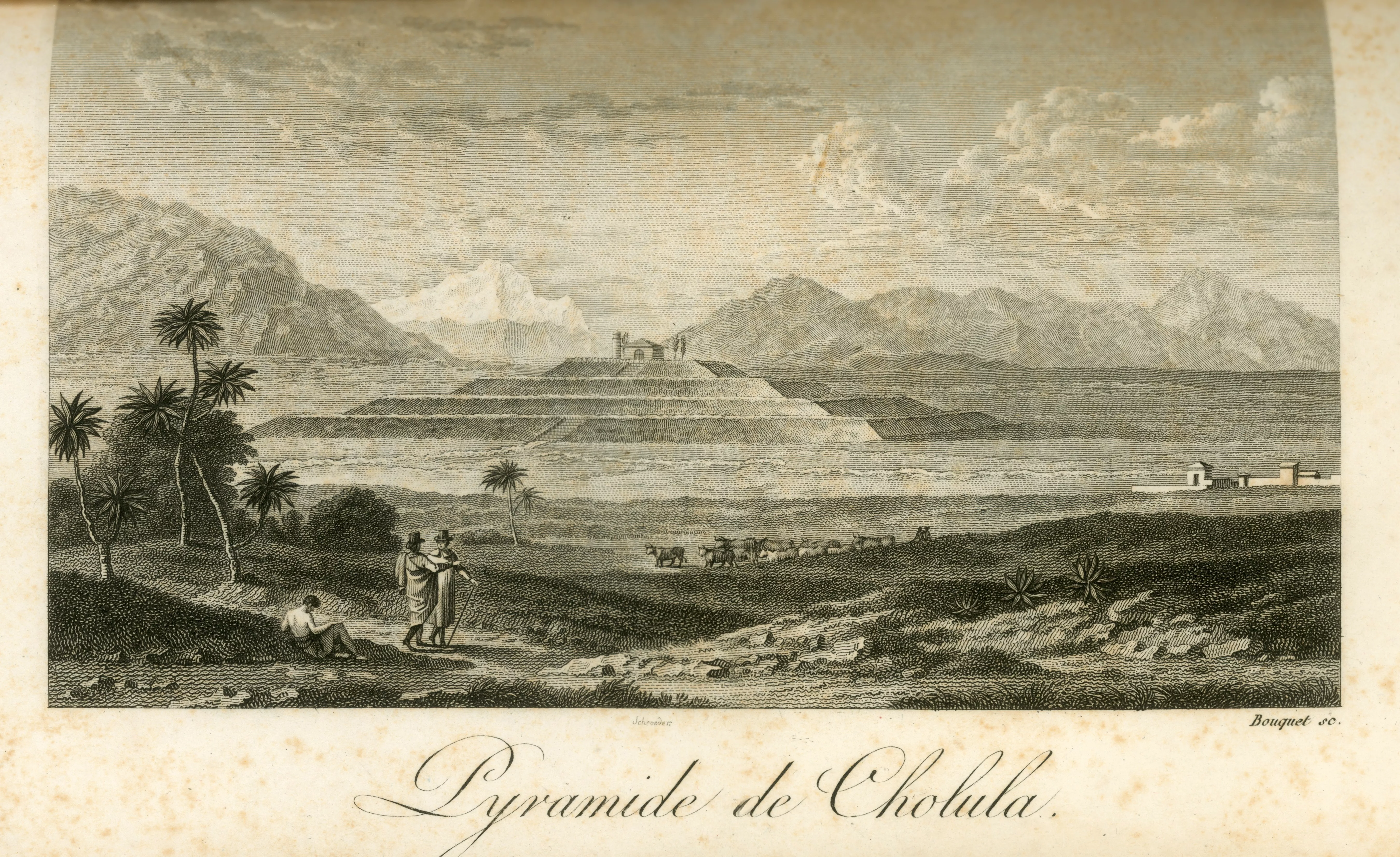Creation Date
1816
Genre
Description
Other than maps, this is the only major landscape image Alexander von Humboldt produced in Mexico. It shows Humboldt's interest in Enlightenment notions of authentic re-creation and encyclopedic recording of native flora and fauna, while also invoking many of the concerns associated with Romantic notions of the picturesque landscape. Pyramide de Cholula was printed for the first time in Humboldt’s Vues des Cordillères: et Monumens des Peuples Indigènes de l’Amérique in 1810. The book was wildly popular in Europe, running to several editions (in a number of languages) throughout the duration of Humboldt’s life. This is one of a long series of images produced for Vues des Cordillères: et Monumens des Peuples Indigènes de l’Amérique, a study of the peoples, cultural artifacts, geography, and natural history of Latin America, particularly South America. Humboldt’s concern was to give an encyclopedic overview of all the aforementioned topics in his book. Given his short time in Mexico, it is significant that Pyramide de Cholula incorporates a city and artifact of Mexican archaeology, a rendering of the Mexican landscape, and representations of native botanical specimens, many of which were collected by Humboldt.
After four years in South America, Alexander von Humboldt arrived in Mexico City from Lima in 1803; he spent a year there devoted to archival research (Pratt 117). His only major archaeological or natural history excursion was to the sites of Cholula (where he produced Pyramide de Cholula) and Xochicalco, a site contemporary to Cholula and located eighty miles from Mexico City.
The four-stepped, low-rising Pyramid of Cholula, covered in sparse vegetation, stands in a flat valley, surrounded by distant mountains. A stairway leads up from the base of the pyramid to the small Spanish church on its crest. A herd of cattle cross the near center of the image, walking away from a small city at the far right. Two men, wearing cloaks, hats, and carrying walking sticks, converse in the left foreground. A semi-nude woman sits nearby, in proximity to a small grove of trees.
Associated Persons
Associated Works
Locations Description
Cholula was an important Mesoamerican population center from around 200 BCE until the time of the Spanish conquest in 1521, at which time it had a population of around 100,000 and was the second-largest city in the Americas (after the Aztec capital of Tenochtitlan). It is located in the modern Mexican state of Puebla, outside the modern city of Cholula (which derives its name from the site). Over the course of its history the city was affected by a number of cultural influences—Teotihuacan, Veracruz, Toltec, and Aztec—many of which contributed to the construction of the Great Pyramid at Cholula.
The Pyramid of Cholula
The Cholula Pyramid was one of the few Mesoamerican archaeological sites to be recorded by German explorer Alexander von Humboldt during his expedition through Spanish America between 1799 and 1804. Considered by many to be the largest man-made monument in the world in terms of volume, the Pyramid of Cholula is unquestionably the largest pyramid in the Americas, and possibly the largest pyramid in the world. Almost twice as large (in volume) than the Great Pyramid of Giza, the pyramid’s initial size has been covered over and re-constructed by succeeding rulers of Cholula over the course of nearly two thousand years; finally, following the Spanish conquest in 1594, a Catholic church was constructed on top of the pyramid. As a result, the overwhelming majority of the structure remains unexcavated by modern archaeologists.
Copyright
Copyright 2009, Rare Book Collection, Archives of the State Historical Society of Wisconsin
Accession Number
F1219 H90
Additional Information
Bibliography
Coe, Michael D. Mexico: From the Olmecs to the Aztecs. 4th ed. London: Thames and Hudson, 1994. Print.
Dettelbach, Michael. "Alexander Von Humboldt between Enlightenment and Romanticism." Alexander von Humboldt's Natural History Legacy and Its Relevance for Today. Spec. Issue of Northeastern Naturalist 8.1 (2001): 9-20. Print.
Humboldt, Alexander von. Vues Des Cordillères: Et Monumens Des Peuples Indigènes De L'amérique. 2 vols. Paris, 1816. Print.
Humboldt, Alexander von, et al. Vistas De Las Cordilleras Y Monumentos De Los Pueblos Indígenas De América. 2 vols. México, D.F.: Smurfit Cartón y Papel, 1995. Print. Hombre y sus obras. Biblioteca Humboldt.
Pratt, Mary Louise. Imperial Eyes: Travel Writing and Transculturation. London: Routledge, 1992. Print.

